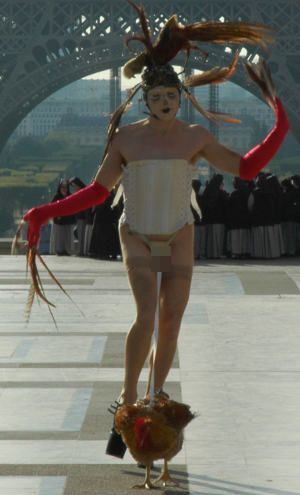
Graffiti defined as drawings scribbled, scratched or sprayed on a surface of a public place, is often seen on buildings and overpasses as one is driving along both city streets and highways. Artist range from kids with markers, or paint to people who have spent years honing their craft and producing arguably amazing pieces of art. However, the line between what is called art and what others call vandalism is often a thin one that is hotly debated.
Graffiti is also a tool for self-expression as most artwork is, and it can be a tool used to inspire change and introspection. These images and paintings can be used as tools to call into perspective the trials of life, politics, social phenomena, as well as other issues and ideas.
In Paris at the Palais de Tokyo, an art museum there is a new form of graffiti emerging and changing the way the art form is both expressed and seen. An artist named Escif, a native of Valencia Spain, is pushing the boundary on where graffiti can be seen.
His exhibition titled “Another Banana Day for the Dream Fish” features a collection of scribbles drawn by a group of 6 to 8-year old’s. Upon first impression these scribbles look like a random collection but with the use of a custom app called “Graffiti Yoga” and augmented reality or AR, they become pictures of “Greco-Roman art”.
Augmented reality uses the camera of your phone to superimpose a computer-generated image onto the real world of the user creating a composite image to view. Escif is using this technology that is readily downloadable for everyone to expose the dichotomy between children drawings and the famous ancient sculptures. This is a new step for the art form where the art can be seen in a virtual method from a less “vandalistic” point of view. Escif’s exhibition does not end at the scribbles on the wall, it includes 13 easter eggs, virtual augmentations to the museum and its art pieces called “Tokemon’s”. Modeled after the AR game Pokémon GO, these are virtual items that can be found when using your phone and the Graffiti Yoga app and viewing the art pieces in the museum. These “eggs” include shopping bags on a Kiki Smith statue and the cast of power rangers under a set of words on a staircase.
The appeal of augmented reality is that it allows for new shapes and expression of graffiti without the need for permission. It also helps make the art form cleaner because you are not permanently defacing a public structure or item. However, this calls into the question whether AR is an access route for virtual defacing of said item. If AR is so freely available could it be used for a purpose other than beneficial could it be used to make fun of these art pieces by adding a red wig to a famous statue for example.
Graffiti has the potential to be used for good and for bad however with the advent of a new “permission-less” method of scribbling, or painting on an object it may make it easier for the more negative effects of the art to be seen. Who is to say maybe this new exploration using technology paired with graffiti is going to be a new avenue for great art or maybe this will lead to some negative uses of the free, permission-less technology. Only time will tell.







